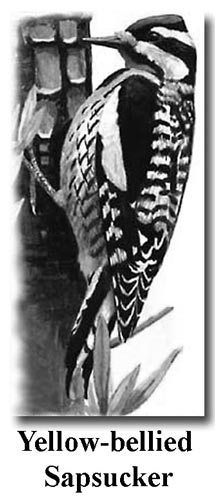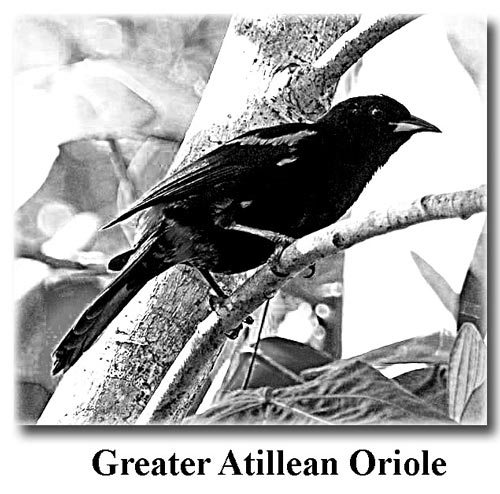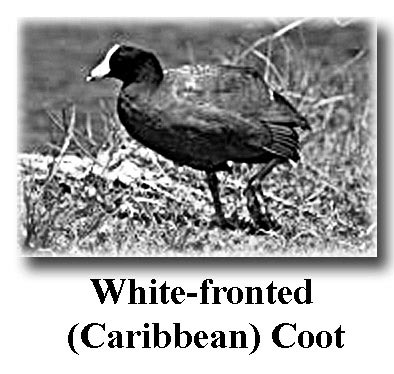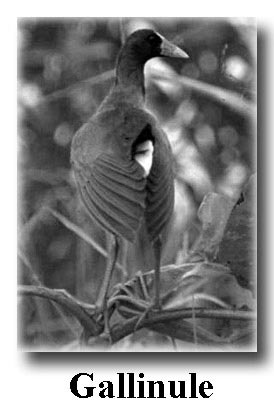A Nineteenth Century Ornithologist at Estate Adrian
(Excerpted from a book by Frederick Ober)
The literary genre of adventure-travel has sustained popularity over many centuries, and travelers’ tales were surely a form of entertainment from the dawn of expressive language. In the 1800’, Americans did not have to go very far to find mysterious wilderness and exotic people to write about: the Florida Everglades or the desert Southwest were thrilling enough for armchair travelers, or, if these palled, there was always the West Indies and the Spanish Main.
The trickle of travelers who came down the island chain and wrote—ususally with shallow insight—about each steamship-stop in turn, became almost a flood by the 1930’. Most of these voyagers stopped at St. Thomas, and some gave revealing glimpses here and there beyond the requisite snapshot of the “town on three hills”, but few indeed found their way to St. John. One account, circa 1910, has the author warned—by no less than three separate “reliable sources” on St. Thomas—that St. John has reverted to a lawless jungle society, probably in fact dangerous for the stranger to approach… far safer to stay on St. Thomas.
Frederick Ober was a young American ornithologist, employed by the Smithsonian Institute in 1877 to collect specimens of West Indian birds. Along with finding several un-recorded species, especially in the lesser Antilles, he wrote a detailed account of his travel adventures titled “The Knockabout Club in the Antilles,” illustrated profusely with attractive engravings by T. Taylor after the drawings of Edouard Riou. (“The Knockabout Club,” in various exotic locations, was actually a popular series, written by many separate travelers.)
This volume actually contains a whole chapter entitled “Bird Hunting in St. Johns” (sic), and while there is a heavily patronizing attitude toward people of color, Spanish, Danes, anyone else with an accent, this is relatively mild compared to some contemporary publications. It is also interesting that Mr. Ober states that it is “no pleasure” for him to kill birds, this in the era when millions of birds were killed for their plumage annually, particularly for the decoration of hats.
The following account from Ober’ book has been much condensed, for the leisurely attitudes of the time certainly extended to self–expression. The largest omission from St. John is a lengthy session of brandy drinking with the Danish judge at the Battery in Cruz Bay…
“The inhabitants of St. Thomas comprise nearly every nationality under the sun, and speak a greater variety of dialects than those of the same area in any part of the world. The most reliable of them, as servants, are the old negroes, who have survived successive catastrophes… belonging to this class was Pappy John, whom I employed to point out the best places in the island for hunting.

…The town lay quiet in the moonlight, but some of the people were astir as we threaded the streets, and it was very cool and delightful, with a delicious earth odor, as we reached the country. By the side of a dry brook bed stood a gri-gri tree, its bark punctured full of holes in circles, which were made, said Pappy John, by a woodpecker, which is not now found in St. Thomas, having been blown away in the great hurricane of 1867. It was speckled like a Guinea-bird he said, and had a yellow crest. {This is almost certainly the yellow-bellied Sap–sucker, which still visits St. John every year, leaving the tell-tale rings of holes, especially on gri-gri and locust trees.} In that same hurricane, a certain species of hummingbird, once abundant here, was blown away forever.… Flying wild over the acacia woods of this part of the island were beautiful birds, –the troopials, foreign to this fauna, and which were introduced to the island from the Spanish Main. {Troupials, a type of oriole, are still seen here occasionally.}

…Another low tree, beneficial to man and smaller animals… is the sour-sop. The agoutis—those curious, hare-like creatures native to these islands—are to be found when ever the sour-sop ripens {agoutis, which may have been a Taino introduction, were abundant on St. Thomas and St. John prior to 1900 and were believed to persist on Little St. James as recently as 1998}, and the wood-rats, thrushes, grives and troopials feed eagerly on the fruit.
…A boat was to have been sent across to take us to St. Johns, but it failed to come, and I hired a burly black man with sinister countenance…and a big boy… The boat was shoved off and ballasted with rocks. Our sail was all tattered and torn, and much resembled the wigwam of a Sioux warrior, with pictures all over it… The wind blew almost half a gale, and was ahead, so it was almost dark before we reached the shores of St. Johns. In the center of the bay we passed over the spot where an immense treasure was found years ago, –an iron chest filled with Spanish gold.
…As our boat ran upon the beach, a black boy met me in the dark and said “Mr. Mac is at the judge’, sah” and then conducted me to the only house at the port.
…Mr. Mac and I rode up the hills in the darkness, my friend riding his honor’ horse, who well kept up the prestige of his name, —“he call Kick-up, sah!”—for he kicked up all the way up.
My object in visiting St, John was to study the avi-fauna—the bird-life—of the island, and to procure a series of specimens for our National Museum. It is not a pleasure for me to kill birds, and it is only the consciousness that such birds go to swell our great collection, and add, in a measure to the knowledge of mankind, supports me in the work… My kind-hearted host sent out… for his best man, a celebrated huntsman, who had lost, by disease, nearly every finger and toe provided him by nature. He was of great service to me, as he knew the haunts of the rare water birds of the lagoons, such as the white-fronted coots and the gallinules.

… Late in the afternoon of my first day here, I wandered into a desolate field, and sat down under a clump of sour-sop trees… the day had been exceedingly hot, but then, at its close, everything was hushed and still. I felt singularly alone, for the house was out of sight, and the only buildings visible were the ruins of negro huts and sugar mills; but all, alas! deserted; the condition of the whole island, with the abandoned estates and ruined dwellings.
At daybreak the next morning, I was out and away over the fields, hunting for pigeons…the air was cool, even cold, as I plunged in to a deep vine-hung ravine, through which ran a stream with gentle flow, bordered by mountain palms and great bare-limbed trees.
The pleasantest excursion was taken to the “Carib Rocks” on the south side of St. John, reached by a rough bridle trail, and lying above a beautiful bay with snow-white sand beach… beyond which the island of Santa Cruz was visible, forty miles away. Up a narrow ravine we walked to a cliff, over which fell a slender thread of water, forming three successive pools…surrounding which were rudely carved faces, and the figure of a cross… there were others in the bed of the waterfall, almost obliterated, showing that the Indians who carved them must have passed away a great while ago.

Returning over the island bridle path, we passed through woods fragrant with the bay, or laurel, and over pastures from which were open views of Tortola, Jost Van Dyke and St. Thomas…
A sudden rain storm coming over, I sought shelter under a giant sand-box tree, near a babbling brook, where were groves of mangoes, avocado-pears and sour-sops, running wild in this delectable valley.
There was also a bois immortelle, a tree fairly scarlet with bloom…swarming with sugar-birds and humming-birds, beneath which I met a French man, once a soldier in Algiers, who was longing to get to America, which is only another name for the United States.
After having been nearly a week the guest of the generous proprietor of the Adrian estate, my duties in other islands called me away, and so I sought means of departure. It was rumored that a boat was to leave from Brown’ Bay, to which point I rode on horseback… But the expected boat was not there, and we wandered for seven hours, aimlessly, exposed to the hot sun… finally returning to Adrian, weary and feverish. But the next day I was more fortunate, –if one may consider himself fortunate, in leaving an island of so many charms,–and chartered a boat for St. Thomas, to which island I sailed in two hours, the wind being aft, and a fresh sea running in our direction.
It was the king’ birthday (April 8), and a man-of-war in port, the “Dagmar”, carrying Prince Valdemar, had its colors flying and was firing royal salutes, which reverberated from cliff to cliff, in answer to the fort ashore. Baron Eggers, whom I dined with that day, a naturalist of some note… informed me that the birds of the southern islands were breeding; and I felt I must hasten away to their breeding places; especially when I met the market women going about with great baskets on their heads, crying “Booby eggs for sale”. For if the boobies had arrived, so had the flamingoes.”
